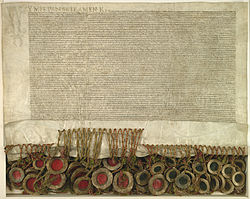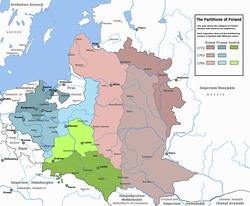Polish–Lithuanian Commonwealth
The Polish–Lithuanian Commonwealth, formally known as the Crown of the Kingdom of Poland and the Grand Duchy of Lithuania and, after 1791, the Commonwealth of Poland, was a state of Poland and Lithuania that was ruled by a common monarch. The Commonwealth was an extension of the Polish-Lithuanian Union, a personal union between those two states that had existed from 1386. It was one of the largest[9] countries in Europe in the 16th and the 17th centuries and had one of the largest populations. The Commonwealth covered more than the present lands of Poland and Lithuania since it also had all of present-day Belarus, a large part of present-day Ukraine and Latvia, and the western part of present-day Russia.
Polish–Lithuanian Commonwealth | |||||||||||||||
|---|---|---|---|---|---|---|---|---|---|---|---|---|---|---|---|
| 1569–1795[1] | |||||||||||||||
| Motto: | |||||||||||||||
| Anthem: | |||||||||||||||
 The Polish–Lithuanian Commonwealth (green) with vassal states (light green) at their peak in 1619 | |||||||||||||||
| Capital |
(de jure)
| ||||||||||||||
| Common languages | Official: Polish and Latin Regional:
| ||||||||||||||
| Religion | Official: Roman Catholicism | ||||||||||||||
| Government |
| ||||||||||||||
| King / Grand Duke | |||||||||||||||
• 1569–1572 | Sigismund II Augustus (first) | ||||||||||||||
• 1764–1795 | Stanisław August Poniatowski (last) | ||||||||||||||
| Legislature | General sejm | ||||||||||||||
• Privy council | Senate | ||||||||||||||
| Historical era | Early modern period | ||||||||||||||
• | 1 July 1569 | ||||||||||||||
| 5 August 1772 | |||||||||||||||
| 3 May 1791 | |||||||||||||||
| 23 January 1793[1] | |||||||||||||||
• | 24 October 1795[1] | ||||||||||||||
| Area | |||||||||||||||
| 1582 | 815,000[6] km2 (315,000 sq mi) | ||||||||||||||
| 1618 | 1,000,000[7][8] km2 (390,000 sq mi) | ||||||||||||||
| Population | |||||||||||||||
• 1582 | ~8,000,000[6] | ||||||||||||||
• 1618 | ~12,000,000 | ||||||||||||||
| |||||||||||||||
The Commonwealth had high levels of ethnic diversity and religious tolerance.[10] However, the amount of religious freedom varied over time.[11]
After several decades of prosperity,[12] it entered a period of political,[13] military and economic[14] decline. The Commonwealth ended with the final partition of Poland in 1795. Its growing weakness had led to it being invaded and divided by its more powerful neighbours: Austria, Prussia and Russia.
Some information
- In Poland, the official languages were Polish and Latin. In Lithuania, the official languages were Old Belarusian, Latin, and Lithuanian.
- The Commonwealth was one of largest countries of its time. It had a large population and at one time covered about 400,000 square miles. Its population was around 11 million. People of different ethnicities lived in the Commonwealth.
- For about 200 years, the Commonwealth fought wars with other powers of Europe of that time: Muscovy Russians, the Ottoman Empire, and the Swedish Empire.
- The Commonwealth developed a system of laws and legislature that reduced the power of the monarch. Some concepts of democracy also developed in the Commonwealth like constitutional monarchy.
- In theory, the two countries of the Commonwealth were equal, but Poland had a leading role.
- The Commonwealth had a major influence of the Catholic Church. However, the government allowed people to practice different religions and so there were many religions in the Commonwealth.
- The Commonwealth also produced a national constitution, which was the first in Europe.
- Agriculture was the main economic activity in the Commonwealth.
Polish–Lithuanian Commonwealth Media
The Union of Lublin joined the Kingdom of Poland and the Grand Duchy of Lithuania in 1569.
Sigismund III Vasa, who reigned between 1587 and 1632, presided over an era of prosperity and territorial expansion of the Commonwealth.
Sejm (parliament) of the Polish–Lithuanian Commonwealth in the early 17th century
John III Sobieski, victor over the Ottoman Turks at the Battle of Vienna in 1683.
Augustus II the Strong, King of Poland and Elector of Saxony, wearing the Order of the White Eagle which he established in 1705.
Partitions of Poland in 1772, 1793 and 1795.
The Royal Castle in Warsaw was the formal residence of Polish kings after the capital was transferred from Kraków in 1596
References
- ↑ 1.0 1.1 Partitions of Poland at Encyclopædia Britannica
- ↑ 2.0 2.1 Janusz Sykała: Od Polan mieszkających w lasach – historia Polski – aż do króla Stasia, Gdansk, 2010.
- ↑ 3.0 3.1 Georg Ziaja: Lexikon des polnischen Adels im Goldenen Zeitalter 1500–1600, p. 9.
- ↑ "Artykuły henrykowskie - szlachecka prekonstytucja".
- ↑ "Poland - the First Partition | Britannica".
- ↑ 6.0 6.1 Panstwowe Przedsiebiorstwo Wydawnictw Kartograficznych: Atlas Historyczny Polski, wydanie X, 1990, p. 14, ISBN 83-7000-016-9.
- ↑ Bertram Benedict (1919): A history of the great war. Bureau of national literature, inc. p. 21.
- ↑ According to Panstwowe Przedsiebiorstwo Wydawnictw Kartograficznych: Atlas Historyczny Polski, wydanie X, 1990, p. 16, ~ 990.000 km2
- ↑ Norman Davies, Europe: A History, Pimlico 1997, p. 554: Poland-Lithuania was another country which experienced its 'Golden Age' during the sixteenth and early seventeenth centuries. The realm of the last Jagiellons was absolutely the largest state in Europe
- ↑ Halina Stephan, Living in Translation: Polish Writers in America, Rodopi, 2003, ISBN 90-420-1016-9, Google Print p373
- ↑ Feliks Gross, Citizenship and Ethnicity: The Growth and Development of a Democratic Multiethnic Institution, Greenwood Press, 1999, ISBN 0-313-30932-9, Google Print, p122 (notes)
- ↑ "In the mid-1500s, united Poland was the largest state in Europe and perhaps the continent’s most powerful nation". "Poland". Encyclopædia Britannica. 2009. Encyclopædia Britannica Online. Retrieved 26 June 2009
- ↑ Martin Van Gelderen, Quentin Skinner, Republicanism: A Shared European Heritage, Cambridge University Press, 2002, ISBN 0-521-80756-5 Google Print: p54
- ↑ The Causes of Slavery or Serfdom: A Hypothesis Archived 2007-12-15 at the Wayback Machine, discussion and full online text of Evsey Domar (1970) "The Causes of Slavery or Serfdom: A Hypothesis", Economic History Review 30:1 (March), pp18–32
Notes
- ↑ Pro Fide, Lege et Rege was the motto since the 18th century.







